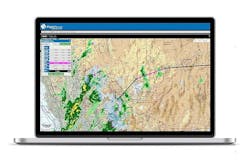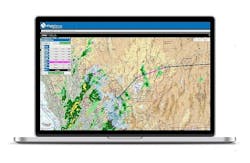Satellite weather technology boosts aviation safety using real-time data, interactive communication in connected cockpits
By Christy Bechtel, Baron Services Inc.
One of the biggest challenges facing global aviation has always been our ability to access accurate real-time aviation weather in the cockpit to address swiftly changing weather conditions that compromise safety. Today, weather remains the number one worry for pilots and aviation industry professionals everywhere and datalink weather remains a hot topic.
Until recently, much of the real-time weather data received domestically in the cockpit wasn’t available to global aviators and was limited to one-way information delivered by satellite where bandwidth constraints and satellite footprints restricted global access or were cost prohibitive. Fortunately, new emerging technology for the connected cockpit via two-way satellite and the advancements made in cloud delivered data open new opportunities for Global weather data delivery. Baron — worldwide providers of exclusive weather data to aviators for more than a decade — has advanced the availability of real-time data for the connected cockpit, changing the scope of real-time information and the way it’s delivered.
Two-way satellite communication creates a smarter cockpit
Similar to cellphones built into cars, the growing trend for today’s pilots is to have connected cockpits featuring two-way, Internet-driven satellite communication. This interactive technology brings a wider selection of data into the cockpit, allowing users to access different types of data or more detailed information for pre-flight and in-flight weather awareness. As a trusted weather services provider staffed 24/7 by trained meteorologists, top scientists and experienced pilots, Baron’s partnership with Sirius XM has been providing dependable weather data to the aviation business for years as the data provider for XMWX Satellite Weather — a standard option in 90 percent of all airframes in America today. Baron’s ability to deliver precise weather data directly to cockpits effectively allows pilots to make smart, informed decisions during flights.
Whether pilots are flying business, commercial, or simply engaged in pleasure aviation, it’s likely they rely on apps for pre-flight planning using Baron’s weather monitoring domestic and global data if there’s Internet in the cockpit. The ability to receive critical data pre-flight and in-flight has earned Baron a reputation for being not only exceptionally responsive, but also innovative, with the quality of data they offer.
Baron Weather API’s easy integration process
“From the moment I saw their API I realized they had really put a lot of thought behind this,” says John Burnside, co-founder and director of technology for iFlightPlanner. “Not only does it utilize the most modern technology standards, the documentation that came along with it was incredibly well-thought out.”For pilots and companies involved with pre-planning, and for aviation app-developers, one of the most useful new aviation-specific weather tracking/data technologies is the Baron Weather API. Designed for easy integration into standard web services or tablets, cell phones, websites, avionic devices, or electronic flight bags (EFBs), access afforded by the Baron Weather API aviation platform gives pilots current storm information and provides critical forecast data allowing them to pre-plan safe routes avoiding unsafe conditions.
The Baron Weather API, unique in offering users flexibility to integrate products into their own applications, supplies extensively documented data designed to efficiently integrate into existing products or services. Offering comprehensive documentation on the Baron Weather API site, along with providing sample code and a detailed data product catalog, modern servers in numerous data centers ensure smooth, reliable performance. Clients consistently receive timely, accurate data with ample support available to help developers with issues or integration questions that might arise.
Pilots employ the Baron Weather API’s exclusive weather data services for safe flight timing and routing decisions, and Baron’s new API cloud data distribution boosts the number and speed of global weather products available to pilots in connected cockpits.
Innovative API products support pre-planning, informed decision making during flight
The primary goal of the Baron Weather API is to use weather awareness to advance public safety. A variety of aviation industry specific API products, designed to efficiently integrate into software, are developed to help pilots, aviation companies and other clients make the safest possible flight plan decisions based on real-time weather data.
For example, to help aviation professionals concerned about precipitation, Global Radar gives pilots a detailed image of current intensity events extending beyond the range of traditional, ground-based radars and supplementing for areas where ground based radars do not exist. Global Lightning, another API product, shows real-time lightning occurrences to help pilots identify and avoid dangerous storms. Global Lightning’s data can be viewed via a heat map that highlights areas where lightning activity is most intense.
Being agile and customer centric gives Baron certain advantages: when customers request information currently unavailable, their developers can design specific products in response. Two perfect examples are the new Baron Flight Cross Section and Global Winds and Temps Aloft. Both innovative API services were requested by the same customer, with the Flight Cross Section equipped to offer the vertical profile of temperature/wind data combined with turbulence and icing. It’s designed for viewing on applications and software as well as in printed form. Global Winds and Temps Aloft merges forecasted wind and temperature data into a single view, displayed in 1,000 foot increments up to 51,000 feet and provides accurate forecast data looking ahead in nine day increments.
Technology driven, next-generation weather data integration
As leaders in aviation weather data services, the Baron Weather API’s expanded product offerings share a common goal of delivering critical weather intelligence to connected cockpits, aviation professionals and companies worldwide. Their aviation-centric products are uniquely designed for easy incorporation into existing aviation company software to make clients’ flight plans safer.
Perhaps more than any other industry, the safety of aviation and flight planning depends upon access to precise, real-time weather information. The Weather API platform of meteorological hardware, software and data supplies critical tools for organizations, companies and individuals involved in an industry directly dependent upon real and forecasted weather conditions. In order to develop innovative ways to collect, decipher, present and display actual, hyper-local meteorological information for those involved in aviation, Baron’s team of top-tier scientists incorporate the best possible modern technology in products that can be counted on to provide weather intelligence.
Baron Weather API Features and Benefits
Interactive technology in the cockpit |
Global weather information |
Provides critical data live |
Integration across many devices |
Integration of products into existing applications |
Whether you’re an aviation industry app developer, creating commercial airline software, or a pleasure pilot operating from a connected cockpit, you can depend on Weather API technology to make communication of critical weather data easily accessible, ensuring flight safety remains a constant priority.
About the author
Christy D. Bechtel is director of business development for Baron Services, Inc.’s enterprise sales department, where she markets and sells API weather data for integration into aviation and public safety customers’ mobile applications, programs, and websites. She also trains sales staff and works closely with software development teams to implement new products and product enhancements. Ms. Bechtel holds a BS in meteorology from The Pennsylvania State University with a minor in global business strategies.
Search the Aerospace & Defense Buyer's Guide
The go-to resource for Intelligent Aerospace technology news & information:
Covering key topics
Across all market segments
Subscribe to the free Intelligent Inbox e-newsletter
Subscribe to receive all the latest aerospace technology news & information, delivered directly to your e-mail inbox twice a week (Tuesdays and Thursdays). Sign upfor your free subscription to the Intelligent Inbox e-newsletter at http://www.intelligent-aerospace.com/subscribe.html.
Connect on social media
Keep pace with aerospace innovation and opportunities via your favorite social media channels. Connect with Intelligent Aerospace on Twitter (@IntelligentAero), LinkedIn,Google+, and Instagram.



